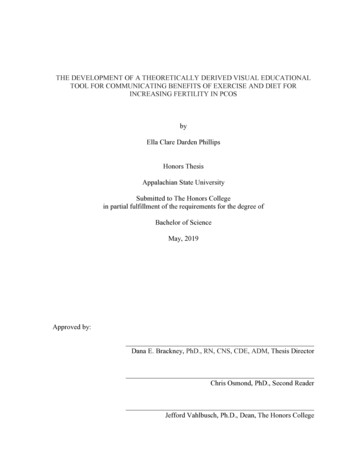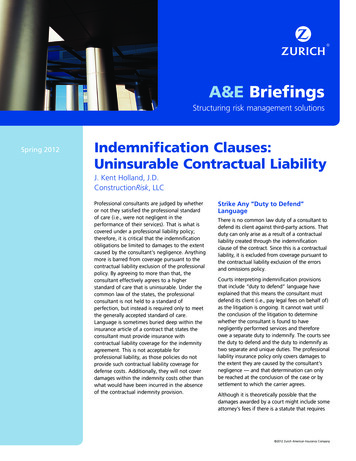
Transcription
THE DEVELOPMENT OF A THEORETICALLY DERIVED VISUAL EDUCATIONALTOOL FOR COMMUNICATING BENEFITS OF EXERCISE AND DIET FORINCREASING FERTILITY IN PCOSbyElla Clare Darden PhillipsHonors ThesisAppalachian State UniversitySubmitted to The Honors Collegein partial fulfillment of the requirements for the degree ofBachelor of ScienceMay, 2019Approved by:Dana E. Brackney, PhD., RN, CNS, CDE, ADM, Thesis DirectorChris Osmond, PhD., Second ReaderJefford Vahlbusch, Ph.D., Dean, The Honors College
Running head: PCOS INFERTILITY EDUCATIONAL TOOL1The development of a theoretically derived visual educational tool for communicating benefits ofexercise and diet for increasing fertility in PCOSElla Clare PhillipsAppalachian State University
PCOS INFERTILITY EDUCATIONAL TOOLAbstractProblem: There is a need to efficiently communicate health messages to women with PCOS inthe management of their fertility.Background: PCOS is a common cause of infertility and creates uncertainty for women desiringa pregnancy. Health care providers do not effectively communicate the benefit of exercise anddiet in increasing fertility. Interpersonal communication theory provides guidance for effectiveprovider-patient communication.Methods: A quality improvement process included the review of the literature using the termshealth communications, health education, picture based messages, framing theory,communication theory, AND PCOS for theoretical guidance. Four transcripts from an ongoingstudy related to PCOS were reviewed and analyzed for themes. The literature review andtranscripts facilitated the development of the PCOS Fertility Education Tool (P-FET).Outcomes: Picture-based messages of PCOS treatment options with accompanying scripts weredeveloped for future testing with people who live with PCOS and desire a pregnancy.Keywords: PCOS, infertility, health communication, health education, picture-basedmessages2
PCOS INFERTILITY EDUCATIONAL TOOL3IntroductionAccording to the Thessaloniki European Society of Human Reproduction Embryology(ESHRE)/American Society for Reproductive Medicine (ASRM) - Sponsored PCOS ConsensusWorkshop Group (2008), Polycystic Ovarian Syndrome (PCOS) affects between 5-10% ofwomen whom have begun menstruating. This autoimmune disease affects PCOS patients’hormones, such as increasing levels of androgen and insulin resistance. Androgen hormones aremale sex hormones. However, both men and women produce androgen. Too much androgen inwomen can lead to the growth of cysts in the ovaries and unwanted symptoms. Commonmanifestations of PCOS include obesity, dysmenorrhea, hirsutism, acne, and can even result ininfertility (Ward & Hisley, 2016). Treatment options for PCOS include oral contraceptive pills,metformin, and hormonal therapy. However, the most preferable option for PCOS treatment islifestyle changes, such as a healthy diet and exercise (Patel, 2018). Women with PCOS whodesire a pregnancy reported that a diagnosis of PCOS was devastating (Huffman, Brackney, &Martin, 2019). In focus groups, these women expressed a need to understand their options forachieving a pregnancy (Huffman et al., 2019).Women with PCOS who want to understand their conception options need a health careprovider who can effectively communicate information about PCOS treatment options. However,successful communication in healthcare is a challenge for providers and their patients(Blackstone, 2015). Hamel (2010) qualitatively researched the level of knowledge health careproviders had regarding communication in a health care setting. Hamel (2010) explains thatproviders face the pressure of increasing their patient load which can decrease the amount oftime spent with each patient. Time constraints can have a negative impact for effective health
PCOS INFERTILITY EDUCATIONAL TOOL4communication with each individual patient. PCOS patients can make informed decisions abouttheir care if healthcare providers use the time they have available to communicate effectively.According to Duggan and Street (2015), a trusting relationship between the provider andpatient must be established before effective communication can occur. Patients are less likely tofollow up with their plan of care if they are dissatisfied with their relationship with theirprovider. The provider should develop a trusting relationship with the PCOS patient whendiscussing difficult information such as diet and exercise behavior change.Dowse (2004), a faculty of Pharmacy at Rhodes University in Grahamstown, SouthAfrica, researches how visual tools can enhance communication of medication informationbetween healthcare providers and their patients. Dowse (2004) explains that visual tools canstrengthen understanding of the information for the patient. Paulovich (2015) used qualitativecase studies with ethnography to examine real-life patient education provided to children withpictures and words to suggest how to improve the health education experience between cliniciansand their patients. Paulovich (2015) claims most patients prefer a visual representation ofinformation. Her findings may translate to the adult health setting. This can be explained byLidwell, Holden, and Butler (2010) who write about the picture superiority effect. The picturesuperiority effect is an idea explaining that pictures can be remembered to a greater extent thanwords, especially if time is limited for delivery of the information. Visual representations ofinformation can enhance education and understanding for patients over a longer period of time(Paulovich, 2015). Patient and provider interactions during an appointment can be limited.Visual aids can allow PCOS patients to take home the information and review it again if needed.Motivational Interviewing can be an effective health communication technique used bythe provider when broaching difficult topics with their patient. Miller and Rollnick (2013)
PCOS INFERTILITY EDUCATIONAL TOOL5advanced the theory of Motivational Interviewing. Miller (1983) originally used thiscommunication technique as a way for providers to communicate with their substance abusepatients to change their behavior. However, the effect of Motivational Interviewing has beenstudied for a variety of health problems such as smoking cessation, hemodialysis adherence, andphysical activity (eg. Bommelé et al. 2017, Russel et al. 2011, & Dunn et al. 2019). MotivationalInterviewing provides counseling to patients by centering the conversation around their personalneeds. The provider is there to facilitate and engage the patient, but ultimately is there to activelylisten as the patient comes to their own conclusions (Miller & Rollnick, 2013).The purpose of this descriptive case example of a quality improvement process is toidentify and apply evidence-based communication theories (the use of visual aids, developing atrusting relationship, and Motivational Interviewing) to design health education materials inorder to effectively communicate infertility treatment options for women with PCOS who desirea pregnancy. The goal is for health care providers to adopt these well-designed health educationmaterials and improve understanding and performance of healthy behaviors in their patients.Review of LiteraturePolycystic Ovarian Syndrome OverviewPolycystic ovarian syndrome is one of the most common diseases of the endocrinesystem. It affects 5-10% of women of childbearing age (Thessaloniki, 2008). There is not a clearpicture of what causes PCOS, and there are differing opinions on how to diagnose and treatPCOS (Thessaloniki, 2008). Overproduction of androgen hormones lead to symptoms includingmenstrual abnormalities, small cysts in the ovaries, hirsutism, acne, and insulin resistance. PCOScan also lead to comorbidities such as obesity, diabetes, heart disease, cancer, psychologicaldisorders, and infertility. (El Hayek, Bitar, Hamdar, Mirza, & Daoud, 2016).
PCOS INFERTILITY EDUCATIONAL TOOL6The endocrine system is made up of the endocrine glands: hypothalamus, pituitary,pancreas, adrenal, thyroid, parathyroid, thymus, pineal, testes and ovaries. Their purpose is toproduce and secrete hormones to stimulate activity in certain cells and tissues. When theendocrine glands are not working properly and produce too much or too little of hormones,complications such as PCOS can emerge (Sole, Moseley, & Klein, 2017).With PCOS, the gonadotropin-releasing hormone (GnRH) is irregularly produced in thehypothalamus (Patel, 2018). Normal production of GnRH leads to the release of the folliclestimulating hormone (FSH) and luteinizing hormone (LH) which play an important role in aregular menstrual cycle. Irregular production of GnRH will affect FSH and LH levels. Abnormallevels of FSH and LH can cause the ovary to respond with overproduction of androgen hormones(hyperandrogenemia) (Patel, 2018). Androgen hormones are male sex hormones such astestosterone. An elevated amount of androgen hormones can cause anovulation or menstrualirregularities (Barnes, 1998).Another possible cause for hyperandrogenemia is insulin resistance (Patel, 2018).Different factors can cause insulin resistance including poor diet, lack of exercise, increasedinflammation and increased cortisol hormone levels. Theca cells, which aid in follicle growth,are irritated by the insulin resistance. The resistance causes the theca cells to surge theproduction of androgen hormones (Patel, 2018).Disruption of these mentioned hormones can lead to the development of cysts in theovaries. Cysts are fluid-filled sacs. Cysts can develop when follicles in the ovaries containing animmature egg (oocyte) are not properly released from the ovary for fertilization. The cysts, calledfunctional cysts, will inhibit ovulation (Patel, 2018).
PCOS INFERTILITY EDUCATIONAL TOOL7Universal diagnostics criteria for PCOS has not yet been accepted worldwide (Wang etal., 2018). Despite the name of the disease, polycystic ovaries alone are not definitive criteria fora PCOS diagnosis. There are three organizations with PCOS consensus guidelines that arecommonly accepted for diagnostic criteria: American Society for Reproductive Medicine inRotterdam, Endocrinology Group in China, and the Endocrine Society in the United States(Wang et al., 2018).In a comparative analysis, Wang et al. (2018) includes the three commonly acceptedguidelines in table form. According to Wang et al. (2018), the American Society forReproductive Medicine met in Rotterdam in 2004 and defined diagnostic criteria for adults to beat least two out of three: hyperandrogenism, menstrual irregularity, and polycystic ovaries.Additionally, the Endocrinology Group in China (2008) defined diagnostic criteria for adults tobe menstrual irregularity, and at least one out of the two: hyperandrogenism or polycysticovaries. The Endocrinology Group in China also define PCOS to be without “thyroiddysfunction, hyperprolactinemia, delayed adrenocortical hyperplasia, 21-hydroxylase deficiency,Cushing’s syndrome, primary premature ovarian insufficiency or premature ovarian failure,ovarian or adrenal androgen-secreting tumors or functional hypothalamic amenorrhea” (Wang etal., 2018, p. 356). Lastly, the Endocrine Society of the United States defines diagnostic criteriafor adults to be at least two out of three: hyperandrogenism, ovulatory dysfunction, andpolycystic ovaries. The Endocrine Society of the United States also defines PCOS to be without“thyroid disease, hyperprolactinemia, or nonclassic congenital adrenal hyperplasia” (Wang et al.,2018, p. 356). Wang et al. (2018) concluded that variations in presentation of PCOS symptomsby ethnicity necessitated a formation of ethnicity-defined guidelines for PCOS diagnosis.
PCOS INFERTILITY EDUCATIONAL TOOL8El Hayek et al., (2016) presents an overview of PCOS and describes how cliniciansreview subjective and objective clinical assessments and appropriate laboratory values for thediagnosis of PCOS. The clinician assesses the patient for hyperandrogenism. Symptoms ofhyperandrogenism may include: hirsutism, acne, androgenetic alopecia (hair loss), andacanthosis nigricans (hyperpigmentation of the skin). Laboratory values such as increased levelsof testosterone and androstenedione would indicate hyperandrogenism as well. The clinician asksthe patient to provide subjective data about their menstrual cycle to determine if the patient hasmenstrual irregularity. Laboratory values would indicate increased levels of LH. To assess forpolycystic ovaries, the provider will use an ultrasonography to determine that there are greaterthan or equal to 12 follicles in each ovary ranging from 2 – 9 mm in size (El Hayek et al., 2016).Patients with PCOS have an increased risk of developing a number of comorbidities dueto the pathophysiology of the disease. It is important to diagnosis a patient with PCOSappropriately to allow for the management of these comorbidities (Patel, 2018). Somecomorbidities patients with PCOS are at risk for can include: obesity, hypertension,cardiovascular disease, dyslipidemia, type 2 diabetes, sleep apnea, uterine cancer, psychologicaldisorders, and infertility (El Hayek et al., 2016; Patel, 2018). The increased risk of infertility isdirectly related to the pathophysiology of polycystic ovaries. The excess androgen hormonesimpair ovarian quality. (El Hayek et al., 2016).Treatment for PCOS consists of managing patient symptoms. Therefore, treatment variesfor each patient with PCOS (El Hayek et al., 2016). Often the first line of treatment for PCOS arelifestyle changes including adopting a lower caloric diet and an increasing exercise (Patel, 2018).In a narrative review, Brennan et al. (2017) cites a study that has shown that a weight loss of 510% of the patient’s body weight can significantly increase ovulation and live births. This
PCOS INFERTILITY EDUCATIONAL TOOL9amount of weight loss can also decrease the patient’s risk for developing comorbidities. In thisprospective study, thirty-three anovulatory and overweight patients with PCOS were asked tofollow a 1200 kcal/day diet and to exercise. Eighteen out of the twenty-five patients who lost atleast 5% of their original weight, developed regular menstrual cycles and fifteen experiencedovulation (Crosignani et al., 2003).Metformin is a medication commonly given to decrease insulin insensitivity in Type 2diabetes. However, in pregnant women with PCOS, metformin was shown to improve outcomesby regulating androgen and LH levels. In a prospective randomized control trial, 32 women withPCOS and 32 women with normal menstrual cycles received either metformin or a placebo for40 days. The results of this study showed that metformin has an effect on the pituitary gland bydecreasing LH levels (Billa et al., 2009). Metformin may also prevent the development ofgestational diabetes if used throughout a pregnancy (Kumar & Khan, 2012). Another commonmedication given is oral contraceptive pills. Oral contraceptive pills manage symptoms bydecreasing LH and testosterone levels. However, using oral contraceptive pills would not bebeneficial for infertility treatment. (El Hayek et al., 2016).A common medication initiated is clomiphene citrate for ovulation if lifestyle changes arenot effectively treating infertility. This medication can be used with or without metformin (ElHayek et al., 2016). Clomiphene citrate is nonsteroidal and induces ovulation by regulating theproduction of FSH and LH to initiate ovulation (Bulun & Adashi, 2016). Next, patients may betreated with exogenous gonadotropins, in vitro fertilization or laparoscopic ovarian drilling iffertility has not been achieved (El Hayek et al., 2016).
PCOS INFERTILITY EDUCATIONAL TOOL10Visual Aid Utilization for Patient EducationUnderstanding how to effectively communicate health information from provider topatient is a complex idea. Patients might not fully comprehend information presented by theirproviders. This is a concept C. Doak, L Doak, and Root (1996) have researched to modify healthcare information for patients to easily comprehend what they are being told. The cause ofconfusion among patients can be for various reasons including ineffective providercommunication or if the patient has low literacy (Doak et al., 1996). A tool that can help withboth of these barriers and can convey information effectively is the use of visual representationsor visual aids for presenting health information (Doak et al., 1996).Doak et al. (1996) explains how visual representations of information have beendetermined to be more influential for the learner than if the information was presented withoutvisual representation. Complicated health information can be understood better with visual aidsbecause it is easier for the human brain to recall a visual image in the memory system than ifpatients were just hearing it verbally (Doak et al., 1996). Picture-based messages can also bebeneficial for language barriers or with communication between cultures (Dowse, 2004).Doak et al. (1996) has made suggestions when designing effective visual aids. Afterdetermining the message to provide, Doak et al. (1996) lists four steps: concentrate on the mainmessage, reduce the amount of reading in the text, provide visual cues and interaction, andprovide motivation.Concentrate on the main message. The health message should not contain too muchdetail in the pathophysiology when designing a visual aid. This can be confusing to patients whodo not fully understand the scientific background. The concept of the visual aid should bestraightforward (Doak et al., 1996).
PCOS INFERTILITY EDUCATIONAL TOOL11Reduce the amount of reading in the text. Visuals can show complex concepts in asimpler way. Patients are more likely to get frustrated and lose interest in long, difficult, hard-toread texts (Doak et al., 1996).Provide visual cues and interaction. The visual aid can be designed to emphasizecertain aspects and important messages within the image. This can be done with arrows, circles,colors, or bolding. These tools can attract the patient’s eye to enhance understanding of the mainconcept (Doak et al., 1996). It is also important for the provider to be involved with thepresentation of the visual aid. The provider should be guiding the patient to notice importantaspects about the image and to provide context about the information. According to Dowse(2004), visual aids should be presented with verbal instruction as well. Visual aids and verbalinstruction of health information are most effective together (Dowse, 2004).Provide Motivation. Visuals that capture the audience will motivate the patient to wantto look at the image further. Using images on the cover of a booklet, to tell a story, or fortestimonials are effective ways to motivate readers to want to look further into the healthmessage (Doak et al., 1996).Overall, picture-based messages can be very influential. Nonetheless, it is important thatthe message is not misinterpreted (Dowse, 2004). Patients with low literacy will have difficultyunderstanding visual representations compared to patients with high literacy. However, providerswill need to assist with guidance for all types of readers, so the visual representation can be fullycomprehended by the patient. The provider should thoroughly explain the information providedin the visual aid. Visual aids should always be presented with verbal instruction to strengthenpatient understanding (Dowse, 2004).
PCOS INFERTILITY EDUCATIONAL TOOL12Motivational InterviewingMotivational Interviewing (MI) was originally designed in the 1980s to counsel patientswith substance abuse issues; however, it has recently been used to help patients with alternativehealth behaviors as well (Smith, 2018). It is a technique that providers can use to counsel patientsinto changing a behavior. It creates an opportunity to shape a conversation that can change thepatient’s outlook on their behavior. It can motivate them to explore and discuss their feelingsabout the certain behavior (Lundahl & Burke, 2009).Motivational Interviewing builds upon other behavioral theories including cognitivedissonance theory (Lundahl & Burke, 2009). Cognitive dissonance theory is the feeling ofdiscomfort a person has when there is discrepancy of their cognitions (beliefs, ideas, values, etc.)and their actions. This feeling of discomfort can lead to a behavioral change (Cooper &Carlsmith, 2015). Patients receiving information from their health care provider might not sparka change in their behavior. Health care providers must also motivate and reduce the patient’sresistance to change. Motivation can increase the likelihood of new behavior adoption (Lundahl& Burke, 2009).The ‘spirit of MI’ is a foundational concept for successful use of MotivationalInterviewing. Miller and Rollnick (2013) discuss the ‘spirit of MI’ when educating health careprofessionals about how to approach the technique. The ‘spirit of MI’ encompasses compassion,collaboration, acceptance and evocation. Another important factor of Motivational Interviewingis that the provider and patient are to develop a trusting partnership for the conversation to bemost successful. The provider’s role is not to tell the patient what they need to do; instead, theprovider’s role is to guide the conversation with compassion. This allows the patient to exploretheir own thoughts on their behavior (Miller & Rollnick, 2013). The purpose of Motivational
PCOS INFERTILITY EDUCATIONAL TOOL13Interviewing is to have the patient become self-motivated and to identify their own reasons forwanting to change their behavior (Miller & Rollnick, 2013).Providers using MI while conversing with their patients about their behavior commonlyuse these concepts: open-ended questions, affirmation, reflective listening, and summary (Smith,2018). It is important to begin with open-ended questions to gauge the patient’s knowledge andtheir feelings about the topic. Additionally, it is essential to ask the patient for permission beforethe provider gives information about the topic. This is because the process is about the patient’sneeds and how they are feeling, not about the provider’s own personal goals (Smith, 2018).Affirmation identifies the patient’s strengths. Reflective listening is a time to develop thepatient’s change talk to be increasingly more positive. The summary is a brief recap of theconversation (Smith, 2018).In a systematic review of four meta-analyses, Lundahl & Burke (2009) compared the useof MI to no intervention or another active intervention (cognitive behavior therapy). Lundahl &Burke reported that the use of Motivational Interviewing increased patient engagement by 5-15%compared to no use of MI and patient engagement also increased with MI compared to cognitivebehavioral therapy but the difference was not significant.According to Lundahl and Burke (2009), researchers are currently constructing the mosteffective means to teach Motivational Interviewing to providers. The most common teachingmethod is professional workshops with post-workshop guidance. These workshops typically areover a 2-day span (9-16 hours) and incorporate didactic lessons and role-playing activities(Lundahl & Burke, 2009).
PCOS INFERTILITY EDUCATIONAL TOOL14MethodsThis descriptive case example follows a quality improvement process method to developclinical education materials for women with PCOS. According to Lobiondo-Wood and Haber(2014), the quality improvement process consists of four steps: assess, analyze, develop, and testand implement. The first three steps were followed for the development of these materials. Thefourth step (test and implement) is itself composed of four steps: plan, do, study, and act. Thisfourth step was not yet performed.In the first step of this quality improvement method, the objective for the improvement isassessed and defined. The objective for this quality improvement case example was to improvecommunication of PCOS health information between health care provider and patient. Sources ofdata for selection of the objective included: expert opinion, focus group transcripts and literaturereview of PCOS management.The second step was to analyze available information related to the objective. A literaturereview was conducted to gather information about effective communication techniques to aid increating an educational tool for women with PCOS who desire a pregnancy. The literaturereview consisted of using terms such as health communications, health education, picture-basedmessages, framing theory, communication theory, AND PCOS. Additionally, four writtentranscripts from an ongoing study of women with PCOS who desired a pregnancy were analyzedto inform the development of the health provider tools. These transcripts were analyzed bylistening for themes in the dialogue and taking notes from what was heard (Huffman et al.,2019).The third step was to develop what was known about the objective into an educationalintervention. The resulting studies from the literature review provided theoretical guidance and
PCOS INFERTILITY EDUCATIONAL TOOL15the PCOS focus groups’ transcripts provided information to clearly communicate with thesepatients about their lifestyle changes treatment options. This information became the foundationfor developing a visual communication tool and a health provider script with MotivationalInterviewing. Picture-based messages were selected due to its demonstrated effectiveness incommunication (Doak et al., 1996). The original concept while creating the educational tool wasto have a two-sided picture-based message portraying useful information and an accompanyingscript for the provider. The tool was intended for providers with patients who have PCOS toeducate about the benefits of diet and exercise for increased ovulation. The visual representationthat was developed was created by using the suggestions provided from Doak et al. (1996):concentrate on the main message, reduce the amount of reading in the text, provide visual cuesand interaction, and provide motivation. Changes to the health education materials were madewith emerging understanding of the theory and from feedback. The health education materialswere shown to content experts, healthcare providers, women of childbearing age, and seniornursing students for feedback throughout its development. This process is a form of memberchecking.Future study will build on this foundation to complete the fourth step (test andimplement) for future advancement of this quality improvement process.Outcomes: Development of Educational ToolThe outcome of this quality improvement process method include health educationalmaterials for women with PCOS who desire a pregnancy consisting of two picture-basedmessages and a Motivational Interviewing guide to communicate the benefits of exercise anddiet for their fertility. The development of these health educational materials transitioned through
PCOS INFERTILITY EDUCATIONAL TOOL16seven different versions. The name of this educational tool is PCOS Fertility Education Tool (PFET).Side One Version OneThe first image constructed was side one of the P-FET. This side of the P-FET shows animage of a scale with a title that reads “Exercise leads to” labeled on the top of the scale and“Pregnancy” labeled on the bottom of the scale. The scale included two tones of blue. The colorscheme was picked because the color blue has been shown to have a calming effect (Valdez &Mehrabian, 1994). A two-sided chart was included in the middle of the scale. The left side of thechart represents the patient’s weight: “300”, “275”, “250”, “225”, “200”, and “175”. The rightside of the chart represents the number of pounds the patient should make as a goal to lose. In theliterature, it was found that a weight loss of 5-10% of the patient’s body weight can significantlyincrease ovulation and live births (Brennan et al., 2017). Seven percent was used in thecalculation because it was thought it would be easier for the patient to read one number for aweight loss goal instead of a range. The weight amounts on this side of the chart included “21pounds”, “19 pounds”, “17 pounds”, “15 pounds”, “14 pounds”, and “12 pounds” (see Figure 1).The first side of the educational tool was shown to three content experts, maternal healthregistered nurses, and senior nursing students completing their mother-baby clinical rotation.Feedback was collected to further develop the first side of the educational tool. The original titleof this side “Exercise leads to Pregnancy” was found to be misleading for the intendedpopulation. The title cannot be a guaranteed statement. Another suggestion recommended to addlabels for each side of the chart. Lastly, it was suggested to identify somewhere on the image thatthe pounds listed for intended weight loss was calculated from 7%.
PCOS INFERTILITY EDUCATIONAL TOOL17Side One Version Two: The Final VersionIn version two of side one, the title was changed to “EGGzercise” and placed inside ofthe scale. On the left side of the chart “Your weight” and the right side “Weight loss goal*” wereadded to clarify the two sides of the chart. The star included at the end of “Weight loss goal*” onthe right side of the chart indicates these numbers were calculated from 7% of the patient’soriginal body weight. At the bottom of the image “*7% of body weight” is labeled to indicatehow the goal for weight loss was found (see Figure 2).Side Two Version OneThe P-FET side two developed with an idea of comparing different fertility methods todiet and exercise. Using different shapes, an image of a baby was created. This baby is the colorpink and is able to change in size. The size of the baby represents the chance of pregnancy tooccur. Thus, the larger the baby, the greater the chance of a pregnancy to occur. A graph wascreated and titled “Pregnancy Success Rates”. The Y-axis includes percentages in increments of10. The X-axis includes the comparing fertility
Treatment options for PCOS include oral contraceptive pills, metformin, and hormonal therapy. However, the most preferable option for PCOS treatment is lifestyle changes, such as a healthy diet and exercise (Patel, 2018). Women with PCOS who desire a pregnancy reported that a diagnosis of PCOS










